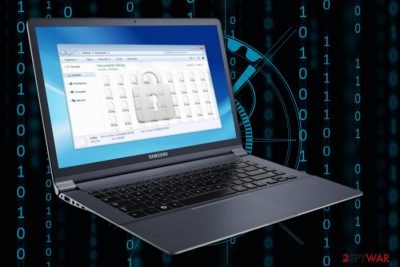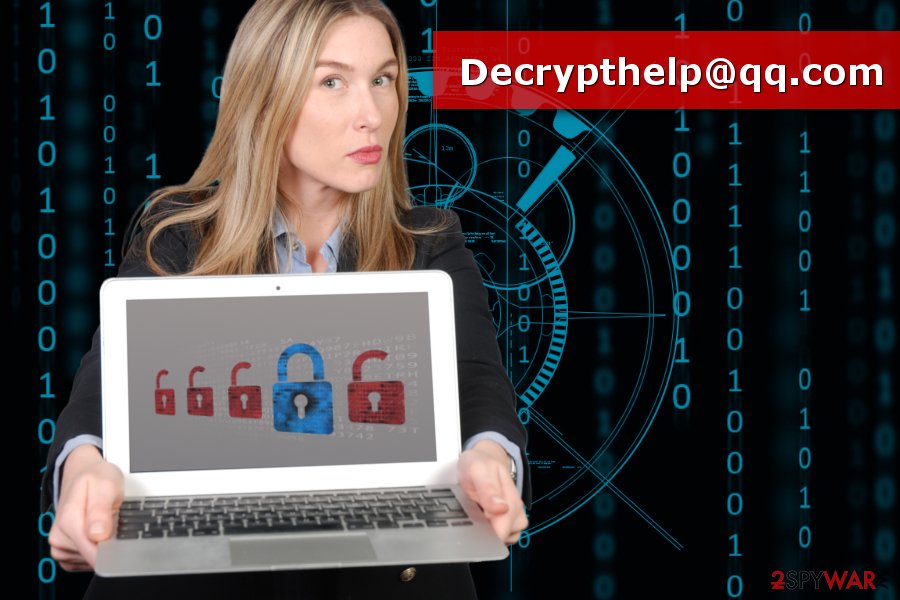Decrypthelp@qq.com ransomware (Simple Removal Guide) - Recovery Instructions Included
Decrypthelp@qq.com virus Removal Guide
What is Decrypthelp@qq.com ransomware?
Decrypthelp@qq.com ransomware locks files with .java file extension on the affected computer

Decrypthelp@qq.com virus is a version of .java ransomware. Both of them belong to Dharma/Crysis malware family that has been threatening computer users and encrypting their files for a couple of years.
Crypto-virus uses AES encryption cipher and appends .[decrypthelp@qq.com].java file extension to the targeted files without leaving a chance to recover or open them. The malicious program aims at the most popular file types to cause more damage to the user and convince into paying the ransom.
Once file encryption is finished, Decrypthelp@qq.com ransomware delivers a ransom note where crooks provide instructions what victims have to do:
Your computer has been infected with Decrypthelp@qq.com Ransomware. All the files found on your drives have been encrypted with a complex algorithm. To regain your access, strictly follow the instructions, provided in the ransom notification.
They are asked to transfer a specific amount of Bitcoins to the provided Bitcoin wallet address. However, security experts advise not to do it.[1] Authors of Decrypthelp@qq.com.java ransomware are not reliable. This illegal file-encrypting program is created for swindling the money only. Therefore, giving victims promised decryptor is just a matter of crook’s conscience.
There’s no doubt that authors of ransomware are not worth trusting. Instead of taking their offer and following their data recovery solutions, you should remove Decrypthelp@qq.com virus from the device using powerful malware removal software.
We recommend FortectIntego for Decrypthelp@qq.com removal. This software can clean the computer and restore damage to the system that may have been caused by the ransomware. The malicious program usually modifies the system and Windows registry in order to boot in system startup.
Additionally, malware might install numerous malicious components and affect important system processes. Therefore, manual elimination is extremely dangerous and complicated process that can be performed by IT specialists. For this reason, you should rely on reputable security tools.
However, we want to stress out that removal of the Decrypthelp@qq.com virus does not bring back your files. Malware removal software does not work as a decryptor. Unfortunately, the official decryptor for this malware is not released yet. Thus, you can only rely on your backups or try alternative recovery options (you can find them presented below).

Methods used to spread ransomware
Developers of file-encrypting virus mostly rely on malspam as the main distribution method. This strategy allows tricking users into opening obfuscated email attachment that contains malicious components.
Usually, these spam emails tell about issues with your bank account or parcel delivery problems.[2] However, they might look as important documents or scanned pics. However, opening these safe looking files, lead to infiltration of malicious programs.
However, the virus might be installed to the system using other methods, such as:
- bogus software downloads;
- fake updates;
- malicious ads;
- exploit kits.
However, taking precautions and avoiding visiting shady websites or clicking unknown links can help to minimize the risk of ransomware attack. Unfortunately, no one can feel 100% safe from the ransomware attack. For this reason, you should also install a reputable antivirus that offers real-time protection.
Security specialists from zondervirus.nl[3] remind that creating backups is also very important. In case of ransomware attack, you won’t be considering paying the ransom and risking to face a financial loss.
Eliminate Decrypthelp@qq.com ransomware virus properly
The only safe way to remove Decrypthelp@qq.com from the computer is to use a powerful security software. We recommend installing FortectIntego or Malwarebytes, updating the program and scanning the system. Ransomware-type cyber threats are complicated and nearly impossible to terminate manually.
After Decrypthelp@qq.com removal, you can recover files from backups. However, if you do not have them, please follow the guide given at the end of the article. There you will find additional recovery methods that might help to restore at least some of the files until the official decrypter is released.
Getting rid of Decrypthelp@qq.com virus. Follow these steps
Manual removal using Safe Mode
If you cannot run automatic Decrypthelp@qq.com ransomware removal, you have to reboot your PC to Safe Mode to Networking.
Important! →
Manual removal guide might be too complicated for regular computer users. It requires advanced IT knowledge to be performed correctly (if vital system files are removed or damaged, it might result in full Windows compromise), and it also might take hours to complete. Therefore, we highly advise using the automatic method provided above instead.
Step 1. Access Safe Mode with Networking
Manual malware removal should be best performed in the Safe Mode environment.
Windows 7 / Vista / XP
- Click Start > Shutdown > Restart > OK.
- When your computer becomes active, start pressing F8 button (if that does not work, try F2, F12, Del, etc. – it all depends on your motherboard model) multiple times until you see the Advanced Boot Options window.
- Select Safe Mode with Networking from the list.

Windows 10 / Windows 8
- Right-click on Start button and select Settings.

- Scroll down to pick Update & Security.

- On the left side of the window, pick Recovery.
- Now scroll down to find Advanced Startup section.
- Click Restart now.

- Select Troubleshoot.

- Go to Advanced options.

- Select Startup Settings.

- Press Restart.
- Now press 5 or click 5) Enable Safe Mode with Networking.

Step 2. Shut down suspicious processes
Windows Task Manager is a useful tool that shows all the processes running in the background. If malware is running a process, you need to shut it down:
- Press Ctrl + Shift + Esc on your keyboard to open Windows Task Manager.
- Click on More details.

- Scroll down to Background processes section, and look for anything suspicious.
- Right-click and select Open file location.

- Go back to the process, right-click and pick End Task.

- Delete the contents of the malicious folder.
Step 3. Check program Startup
- Press Ctrl + Shift + Esc on your keyboard to open Windows Task Manager.
- Go to Startup tab.
- Right-click on the suspicious program and pick Disable.

Step 4. Delete virus files
Malware-related files can be found in various places within your computer. Here are instructions that could help you find them:
- Type in Disk Cleanup in Windows search and press Enter.

- Select the drive you want to clean (C: is your main drive by default and is likely to be the one that has malicious files in).
- Scroll through the Files to delete list and select the following:
Temporary Internet Files
Downloads
Recycle Bin
Temporary files - Pick Clean up system files.

- You can also look for other malicious files hidden in the following folders (type these entries in Windows Search and press Enter):
%AppData%
%LocalAppData%
%ProgramData%
%WinDir%
After you are finished, reboot the PC in normal mode.
Remove Decrypthelp@qq.com using System Restore
This method might also help to disable the virus and get rid of it automatically:
-
Step 1: Reboot your computer to Safe Mode with Command Prompt
Windows 7 / Vista / XP- Click Start → Shutdown → Restart → OK.
- When your computer becomes active, start pressing F8 multiple times until you see the Advanced Boot Options window.
-
Select Command Prompt from the list

Windows 10 / Windows 8- Press the Power button at the Windows login screen. Now press and hold Shift, which is on your keyboard, and click Restart..
- Now select Troubleshoot → Advanced options → Startup Settings and finally press Restart.
-
Once your computer becomes active, select Enable Safe Mode with Command Prompt in Startup Settings window.

-
Step 2: Restore your system files and settings
-
Once the Command Prompt window shows up, enter cd restore and click Enter.

-
Now type rstrui.exe and press Enter again..

-
When a new window shows up, click Next and select your restore point that is prior the infiltration of Decrypthelp@qq.com. After doing that, click Next.


-
Now click Yes to start system restore.

-
Once the Command Prompt window shows up, enter cd restore and click Enter.
Bonus: Recover your data
Guide which is presented above is supposed to help you remove Decrypthelp@qq.com from your computer. To recover your encrypted files, we recommend using a detailed guide prepared by 2-spyware.com security experts.Currently, the only way to recover files after the ransomware attack is to use backups. Otherwise, you can only test your luck by trying alternative tools.
If your files are encrypted by Decrypthelp@qq.com, you can use several methods to restore them:
Check Data Recovery Pro
This professional software is designed to restore corrupted or accidentally deleted files. However, it might be useful after ransomware attack too.
- Download Data Recovery Pro;
- Follow the steps of Data Recovery Setup and install the program on your computer;
- Launch it and scan your computer for files encrypted by Decrypthelp@qq.com ransomware;
- Restore them.
Use ShadowExplorer to recover files from shadow copies
If Decrypthelp@qq.com did not delete Shadow Volume Copies of the targeted files, you should try ShadowExplorer to restore corrupted files:
- Download Shadow Explorer (http://shadowexplorer.com/);
- Follow a Shadow Explorer Setup Wizard and install this application on your computer;
- Launch the program and go through the drop down menu on the top left corner to select the disk of your encrypted data. Check what folders are there;
- Right-click on the folder you want to restore and select “Export”. You can also select where you want it to be stored.
Decryptor for Decrypthelp@qq.com ransomware is not available yet.
Finally, you should always think about the protection of crypto-ransomwares. In order to protect your computer from Decrypthelp@qq.com and other ransomwares, use a reputable anti-spyware, such as FortectIntego, SpyHunter 5Combo Cleaner or Malwarebytes
How to prevent from getting ransomware
Choose a proper web browser and improve your safety with a VPN tool
Online spying has got momentum in recent years and people are getting more and more interested in how to protect their privacy online. One of the basic means to add a layer of security – choose the most private and secure web browser. Although web browsers can't grant full privacy protection and security, some of them are much better at sandboxing, HTTPS upgrading, active content blocking, tracking blocking, phishing protection, and similar privacy-oriented features. However, if you want true anonymity, we suggest you employ a powerful Private Internet Access VPN – it can encrypt all the traffic that comes and goes out of your computer, preventing tracking completely.
Lost your files? Use data recovery software
While some files located on any computer are replaceable or useless, others can be extremely valuable. Family photos, work documents, school projects – these are types of files that we don't want to lose. Unfortunately, there are many ways how unexpected data loss can occur: power cuts, Blue Screen of Death errors, hardware failures, crypto-malware attack, or even accidental deletion.
To ensure that all the files remain intact, you should prepare regular data backups. You can choose cloud-based or physical copies you could restore from later in case of a disaster. If your backups were lost as well or you never bothered to prepare any, Data Recovery Pro can be your only hope to retrieve your invaluable files.
- ^ Jesus Vigo. The ransomware debate: Should you pay to get your data back?. TechRepublic. News, tips, and advice for technology professionals.
- ^ Rick Broida. How to spot a phishing email. CNET.Product reviews, how-tos, deals and the latest tech news.
- ^ ZonderVirus. ZonderVirus. Dutch cyber security news.
• Polski
• Deutsch
• Português
• Español
• Suomen
• Norsk
• Magyar
• 日本語
• English (UK)





















